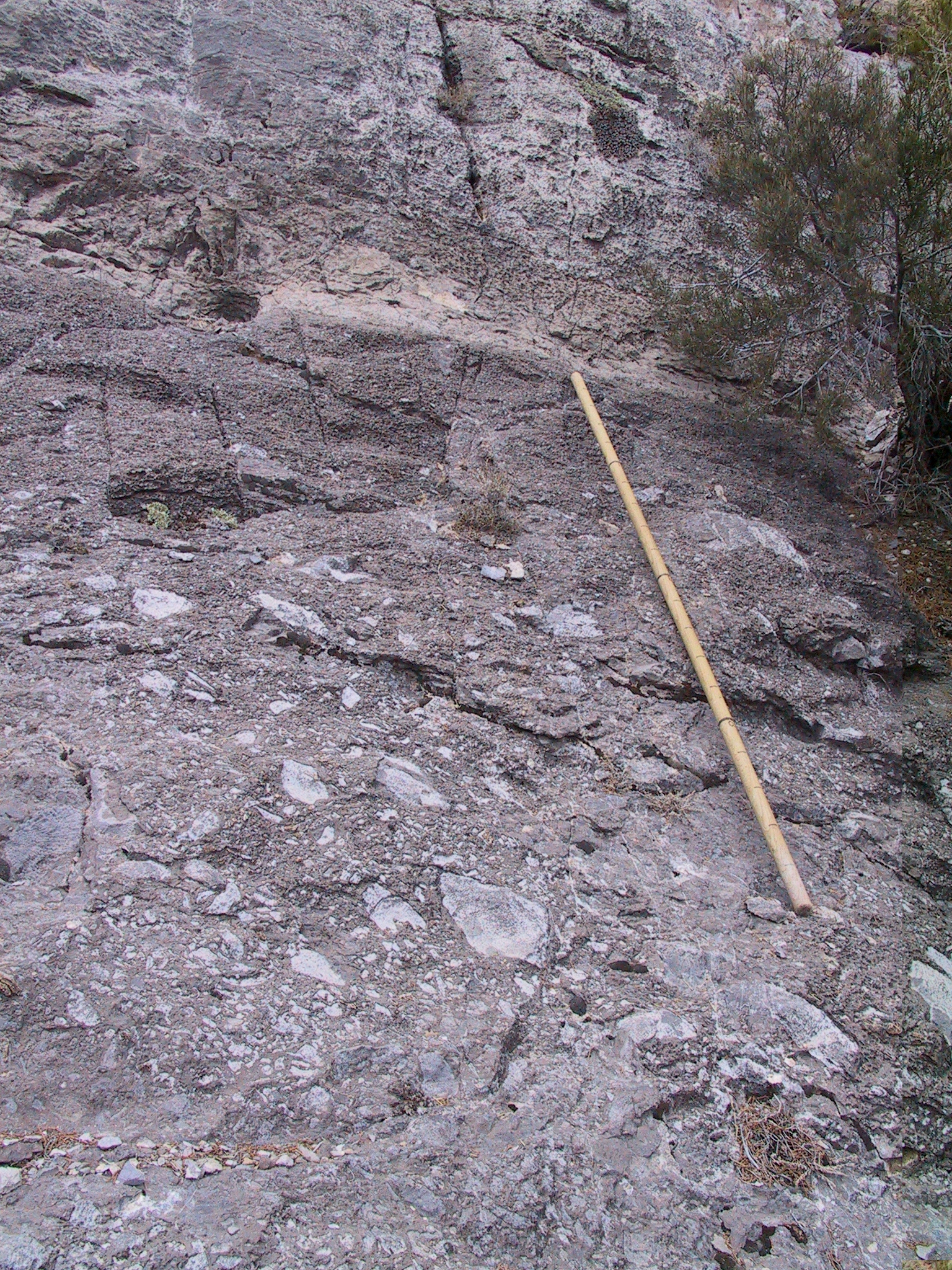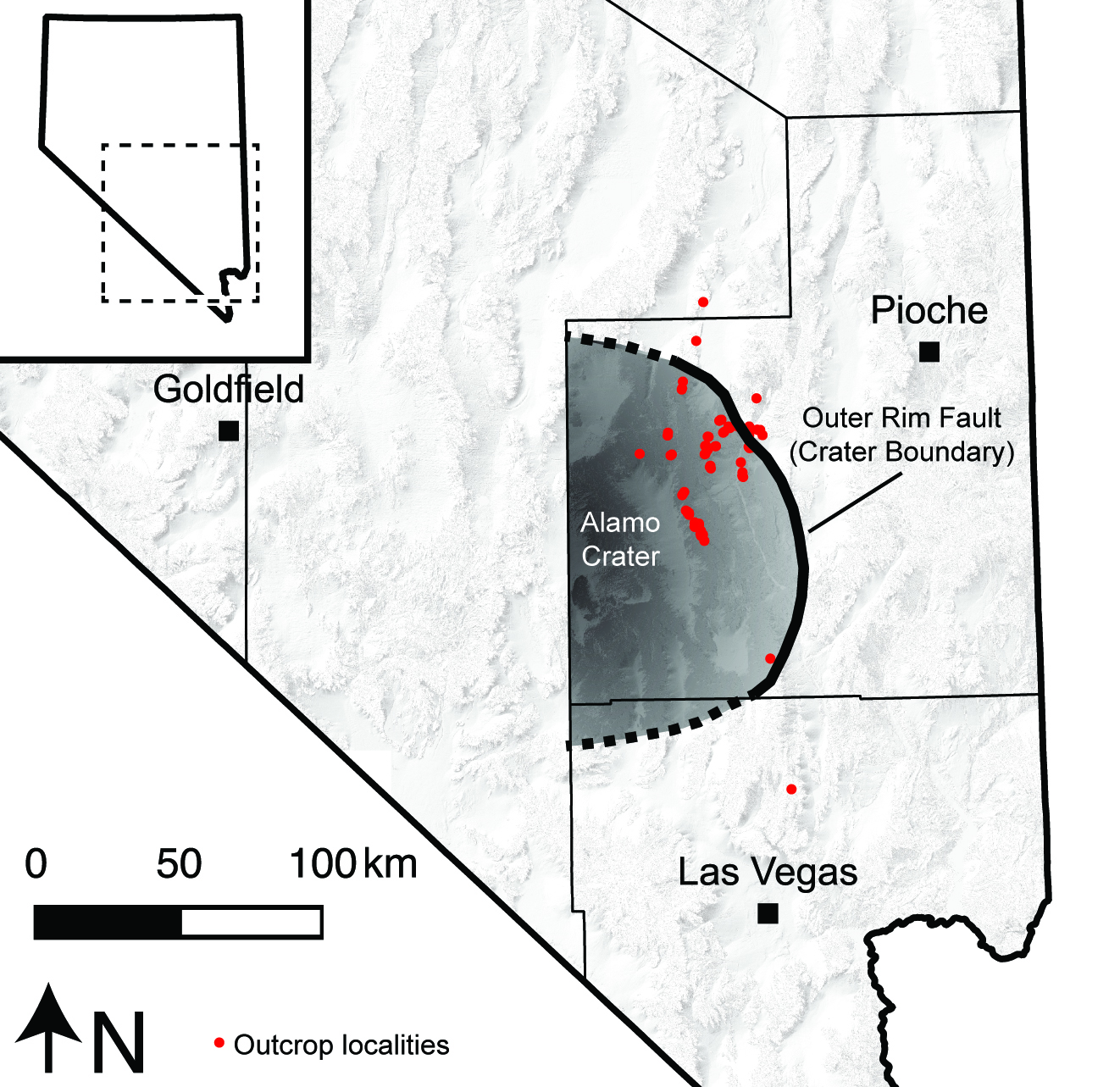America's Amazing, Drivable Crater: Alamo Impact Yields Secrets

One of America's biggest impact craters was sliced and diced until it spread across Nevada like a plate of crudités.
Now, after scaling more than 20 mountain ranges in the sweltering desert sun, geologists have reassembled the crater into a semblance of its original shape. Evidence provided by pulverized rocks suggests the crater was more than 90 miles (150 kilometers) wide, as big as the Chesapeake Bay impact crater offshore Virginia. The findings, published Jan. 14 in the journal Geosphere, offer the most comprehensive view yet of the Alamo crater, the most accessible impact crater in North America.
If you drive along Nevada's Extraterrestrial Highway, you're traveling through the Alamo impact crater. Just near Hancock Summit and the foothills of the Pahranagat Range, not far from Area 51, are some of the most spectacular exposures of these unusual rocks. They were created when a meteorite or comet slammed into western North America sometime in the Devonian Period about 382 million years ago, according to several studies. [Photos: Amazing Rocks from the Alamo Impact Crater]
Marking the past
Few underwater impact structures this old survive today; that's because oceanic crust, where the crater lies, is constantly reworked. But this ancient, shallow carbonate shelf — similar to today's Bahamas — managed to endure several cycles of mountain building along western North America.
Only half of the crater is exposed above the surface, but anyone can drive or hike up to the rocks and examine the site's strange features. There are microscopic shards of shocked quartz, the hard mineral shattered by the force of the impact. In a few spots, geologists have detected high levels of iridium, a mineral common in space but rare on Earth. A megatsunami raced outward for hundreds of miles after the impact, and scientists have found evidence of a huge wave as far away as Utah.
Most distinctive is an impact breccia with a jumble of ripped-up rocks, some as long as cargo ships. (A breccia is a rock made of angular rock fragments that are cemented together, similar to concrete.) Within the breccia are lapilli, tiny balls of molten limestone that formed from vaporized rock thrown into the air during the impact. The lapilli contain fossil conodonts, the microscopic teeth of an ancient, eel-like fish that resembled hagfish.
Get the world’s most fascinating discoveries delivered straight to your inbox.
"The breccia looks like a solid rock, but it's made up of a bunch of chunks of other rocks. There are a ton of fossils in it, different kinds of sponges and brachiopods and also some algae," said Andrew Retzler, lead study author and a research scientist at the Minnesota Geological Survey. "Once you get a sense of how it weathers, your eye gets drawn to it in the mountain ranges."
Geologists first assembled these clues in the 1990s, announcing discovery of the crater in 1997. Now, Retzler and his co-authors at Idaho State University have painstakingly mapped the thickness and position of different rock layers within the crater to precisely determine its size and shape. [In Photos: The Impact Craters of North America]
It turns out the impact breccia rocks mark the crater edge by dramatically changing thickness. The sudden increase shows where post-impact waves dumped rock debris into the crater hole. (A sandbar also formed around the crater rim, where waves piled sand against the raised edge.)
"We eventually found a pattern in the rocks that showed us when we were right where the edge of the crater was," said Leif Tapanila, a paleontology professor at Idaho State University and co-author of the new study. "You could effectively put your foot on that margin."
The researchers' reconstruction yields a crater diameter of 69 to 93 miles (111 to 150 km). This means the crater was likely between 2.3 to 4 miles (3.7 to 6.5 km) deep, the study reported.
"It's a detective story," said Tapanila. "We're using our tools to read the rocks and piece the crater back together."
Little impact
Despite the crater's size, it seemed to barely touch life on Earth. In the middle of the Late Devonian Period, one of Earth's largest extinctions appears in the fossil record, but the Alamo impact didn't play a role. It occurred about 3 million years too early to have any connection to the mass die-off. And rocks immediately above the crater hold fossils that are very similar to rocks below the impact, suggesting the impact site was quickly repopulated by the area's sponges, snails, fish and primitive corals.
"Here's a great example of what happens when a meteor or comet hits a marine environment," Tapanila said. "And it doesn't really do a whole lot."
Because half of the Alamo impact crater is buried beneath the earth, there are many remaining mysteries to be solved. "No one knows what the heck made this impact," Tapanila said. No meteorite chunks or extraterrestrial minerals have turned up in the impact-related rocks, so perhaps an icy comet, rather than a meteorite, carved the crater. Geochemical work on the rocks might reveal more details about the source, Tapanila said.
And the impact crater has not earned a spot on the Earth Impact Database, the list of confirmed impact craters maintained by the University of New Brunswick in Canada. (However, no one who studies the Alamo crater has submitted evidence such as shocked quartz or shatter cones, fractured rocks that are shaped like ice-cream cones and have a unique pattern created only during impacts.)
"It's a bit like forensics," said John Spray, director of the University of New Brunswick's Planetary and Space Science Centre and keeper of the database. "All impact structures are cold cases. Sometimes, they are so beat up we don't even know what they were and whether they were even craters or not."
At the time of impact, the Alamo crater was about 120 miles (200 km) west of its current location, said Charlie Sandberg, an emeritus geologist with the U.S. Geological Survey in Denver, Colorado, and one of the scientists who first identified the crater. Since the Devonian Period, western North America has crumpled inward because of collisions with other tectonic plates, building up the region's spectacular mountain ranges. The tectonic forces faulted and tilted the impact crater rocks, partially burying the crater. Volcanic eruptions also concealed some Alamo impact rocks. Finally, some rocks are also inaccessible, because they cross Area 51 and the Nevada Test Site.
Despite all this, "it is certainly the best crater in North America," said Sandberg, who helped puzzle out the crater in the 1990s. "It is probably the most accessible crater anywhere on Earth."
Follow Becky Oskin @beckyoskin. Follow LiveScience @livescience, Facebook & Google+. Originally published on Live Science .





